#Kibbutz Ramat Rachel
Text

Rare Bronze Mirror Found in 2,300-Year-Old Grave of Greek Courtesan in Jerusalem
Archaeologists in Israel have discovered what they believe to be the remains of an Ancient Greek courtesan.
The cremated remains of a young woman were found in a burial cave alongside a perfectly preserved bronze box mirror on a rocky slope close to Kibbutz Ramat Rachel, not far from Jerusalem.
The tomb is believed to date back to some time between the late 4th century and early 3rd century BCE, according to a joint study carried out by Tel Aviv University and the Israel Antiquities Authority (IAA).
Guy Stiebel, from the department of archeology and the Ancient Near East at Tel Aviv University, saiid in a phone interview that the find is “very significant.”
“It’s almost like bringing back to life a woman who passed away 2,300 years ago,” he said of the research, which he compared to a “jigsaw puzzle or riddle.”
He and his team believe this could be the first discovery of the remains of a hetaira, as courtesans were known in Ancient Greece.
“If we are correct with our interpretation, it appears that this burial points to the very unique circumstances of what we call a hetaira, a Greek lady who accompanied one of the Hellenistic government officials, or more likely a high general,” he said.
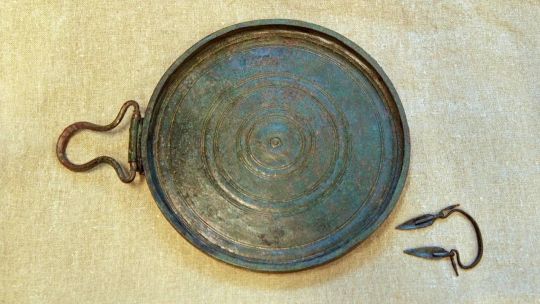
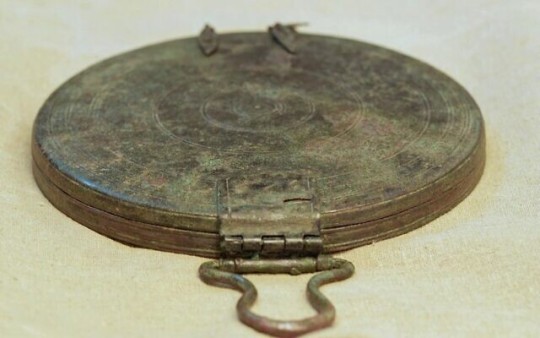

In the Middle East and eastern Mediterranean, the Hellenistic age refers to the period between the death of Alexander the Great in 323 BCE and the conquest of Egypt by Rome in 30 BCE. Stiebel said that he and his team believe the woman would have been among the first Greeks to arrive in the region.
Liat Oz, the director of the excavation on behalf of the IAA, described the mirror found in the tomb alongside the remains.
“This is only the second mirror of this type that has been discovered to date in Israel, and in total, only 63 mirrors of this type are known around the Hellenistic world,” she said in a news release about the discovery.
“The quality of the production of the mirror is so high that it was preserved in excellent condition, and it looked as if it was made yesterday.”
Folding box mirrors such as this were documented in tombs and temples in the Greco-Hellenistic world, the researchers noted. They were usually decorated with engravings or reliefs of idealized female figures or goddesses.

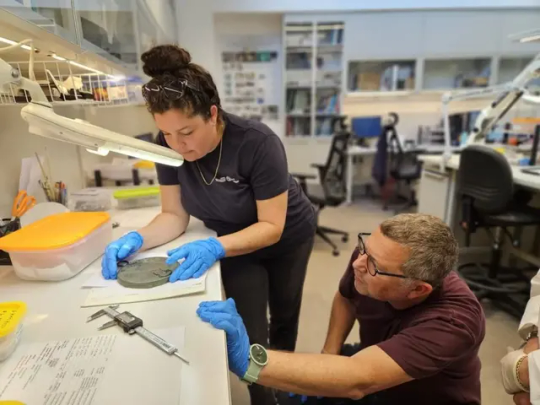
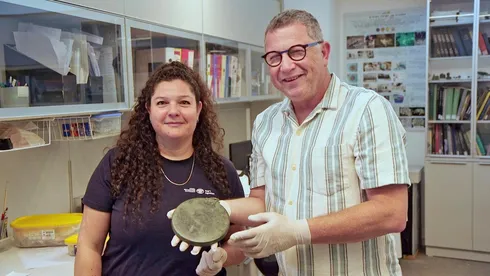
Stiebel said a woman of high status might have received such a mirror as part of a dowry, but this was unlikely to have been the case in this instance as married women rarely left their homes in Greece.
Alternatively, he said, she might have been a courtesan, as they often received gifts from men. Likening the hetairai to Japanese geishas, Stiebel explained that the women were regarded as “muses.”
He said: “Women in society were breaking glass ceilings in very strict and male-oriented Greek society and we do know that they served not only as sexual escorts, but were similar to geishas and provided an element of culture. For that they were given gifts and part of the economy of gifts in Ancient Greece had to do with mirrors.”
The fact the remains were cremated also hinted at the woman’s origins, Stiebel said.
“Cremation is alien to this country and the religion,” he said, explaining that cremation is not only forbidden in Judaism but would not have been practiced by the Persian empire either, which occupied the region at that time.
“The tomb was found in the middle of nowhere, not near any village or farm or settlement, which suggests that she would have been connected with one of the military campaigns and dated to the time of Alexandra the Great or slightly later.
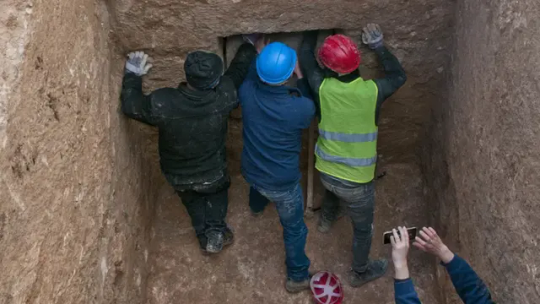


“We are suggesting that maybe she was with one of the generals.”
Stiebel went on to explain the significance of four iron nails found with the mirror and remains.
“Nails were used to protect the deceased and also to protect the living people from the dead. The bodies were literally nailed down to ensure they will not come back to the world of the living,” he said.
Stiebel said that the team are continuing with further research in order to “zoom in” on the finer details of the mirror.
He said: “We hope to shed more light on the origin of the production of the art and maybe shed more light on the history of the owner of the mirror, the general who bought it or where she came from.”
The research will be presented for the first time at an Israeli archaeology conference next month.
By Lianne Kolirin.
#Rare Bronze Mirror Found in 2300-Year-Old Grave of Greek Courtesan in Jerusalem#Ancient Greek courtesan#Kibbutz Ramat Rachel#ancient tomb#ancient grave#ancient artifacts#archeology#archeolgst#history#history news#ancient history#ancient culture#ancient civilizations#hellenistic period#persian empire#greek history
80 notes
·
View notes
Photo

Another side of Jerusalem Day.
This is a pic of my friend Naftali Aklum. His brother was an unsung Mossad agent and hero who was key to leading thousands of Ethiopian Jews from Ethiopia via Sudan to Israel in a secret Mossad operation.
For those who don't know, Jerusalem Day is also a memorial day for the ~4000 Jews of the Ethiopian community who died along the long dangerous journey to Israel.
In this pic on Mount Herzl, my friend stands at the memorial for the Ethiopian Jews who perished, while pointing at the name of his grandfather who perished in Sudan. May their memories be a blessing!
"The story of Ethiopian Jewry is an essential part of the story of Zionism and the history of the Jewish people," said Yair Shachal, secretary-general of Bnei Akiva.
More about Naftali's hero brother here:
More about the memorial day here:
On the 28th of Iyar (today's Jewish date), the State of Israel also marks the memorial day for members of the Ethiopian Jewish community who perished on their way to Israel.
A mass emigration of Ethiopian Jews ("Beta Israel") took place in the years 1980-1984, from their villages in the area of Gundar and through Sudan. Many of them, who had dreamed for many years of making Aliyah to Israel, managed to flee Ethiopia and arrive at the Ethiopian-Sudanese border, where they waited in provisional camps to make Aliyah. The passage through Sudan was made possible by an unspoken agreement, known only to a few senior officials in Sudan. Agents of the Mossad awaited the immigrants at the Sudanese border and instructed them to hide their Jewish identity.
On their escape routes and in the Sudanese camps, they suffered from disease, hunger and acts of harassment, rape, and violent robberies. The families, with their elderly and younger members, walked for long periods of up to several months and were forced to wait in refugee camps in Sudan for up to two years until they could be rescued and brought to Israel.
Approximately 4,000 members of the community perished on the way and in the camps, in their attempt to arrive at Israel. The instructions they were given by the Mossad agents to conceal their Jewish identity made it difficult for them to observe the laws of kashrut and ritual purity; in the desert, they could not bury their dead for fear of robbers, and in their camps, they could not perform Jewish burial ceremonies for fear of the Sudanese guards.
Operation Moses, the first national operation for bringing Ethiopian Jewry to Israel, began in November 1984. The operation was done in secret and brought over some 8,000 Ethiopian Jews on Israeli aircraft. A leak of information to the Israeli press brought the operation to an end before schedule. Many families were left behind, torn apart and separated; they remained there until May 1991, when 14,324 immigrants were brought within 36 hours during Operation Solomon.
In 1989, the Ministry of Immigrant Absorption erected a temporary memorial for the Ethiopian Jews who perished on the way to Israel. This memorial was set up at Kibbutz Ramat Rachel, with the help of the Jewish National Fund (KKL-JNF) and the Jewish Agency. In late 2003, the Ministerial Committee for Immigration, Absorption and the Diaspora decided that a permanent memorial would be established at Mt. Herzl. The government decided that a national memorial ceremony for those who perished would be held each year on the 28th of Iyar, Jerusalem Day.
In March 2007, the memorial for Ethiopian Jews who perished on the way to Israel was dedicated in the southern part of Mt. Herzl. The area surrounding the memorial serves as a gathering place in which people can cherish the memory of the courage and the loss of the thousands of Ethiopian Jews who perished on their way to Israel.
Uri Gobey
25 notes
·
View notes
Text

++++courtesy of HSA-Holocaust Social Archive++++++++++++++++
She was the troubled daughter of the rabbi of Warsaw’s great synagogue; he was the son of a Polish Jewish leader. As neighbors they used to play together as children, but when they grew up, each went on their separate way. The leader’s son became a communist who fought in the Brigade in Spain, and did not immigrate to Israel with the rest of his family. The daughter of the rabbi married a successful lawyer and they were among the aristocratic Bohemia of Warsaw and were the parents of a single child, born after 11 years of marriage.
After the Nazi occupation, the spoiled boy arrived in the Warsaw ghetto, learned how to walk through cracks in the wall and bring food from the garbage cans. His mother called her former nanny who took him to her village, where she introduced the blue-eyed and blond-haired boy as her nephew, but warned him not to expose his body in front of other children.
The leader’s son was captured in France and sent to Auschwitz, where his friends asked him to represent them because he was a jurist and proficient in languages. In fact, he became a Kapo, and to this day, there are differences of opinion about the degree of cruelty he discovered in this position and the part he took in the resistance and camp’s underground.
The Rabbi’s daughter’s husband perished in the camp, and after the liberation she arrived in Jerusalem weighing 35 Kg. With the help of her family, she found her son in a village in Poland. She brought him to Israel but was unable to raise him and he was sent to ‘Kibbutz Ramat David’.
The leader’s son was arrested and tried in Paris as a collaborator with the Nazis, and some claim that the fact he opposed Stalin played a part against him. His father left all his pursuits and fought for his credit. After the trial ended and he was found ‘not guilty’, he came to Israel and lived in his parents’ house in Jerusalem, where he met again with the daughter of the rabbi and they fell in love. She started gaining weight and the two talked about getting married and the boy’s return from the kibbutz.
The leader’s son wanted to join the IDF but was refused because of his past, and was recruited only after the war of independence started. In a battle in Ramat-Rachel, an order of withdrawal was issued but the leader’s son stormed at the enemy in what appeared as a suicidal action, and was killed.
When the rabbi’s daughter heard of his death, she declined his parents’ offer to mourn with them, went to her home and took her own life.
Away from besieged Jerusalem, the child who knew in his life, wealth, hunger in the ghetto, life in a Polish village and a kibbutz was left orphaned and alone.
From the fascinating book “Kapo in Auschwitz” by Professor Tuvia Friling.
Link to the book’s preview:
https://www.academia.edu/26350561/A_Jewish_Kapo_in_Auschwitz_History_Memory_and_the_Politics_of_Survival
Link to the book’s reviews:
https://www.academia.edu/36873051/A_Jewish_Kapo_in_Auschwitz_-_Book_Reviews
Link to purchase the book:
https://www.amazon.com/Jewish-Kapo-Auschwitz-Politics-Schusterman/dp/1611685877
Source
https://www.facebook.com/groups/HSA.Archive
A TRAGIC LOVE STORY ++++courtesy of HSA-Holocaust Social Archive++++++++++++++++ She was the troubled daughter of the rabbi of Warsaw’s great synagogue; he was the son of a Polish Jewish leader.
0 notes
Video
undefined
tumblr
Find All Holy Land Churches at Ramat Rachel.Ramat Rachel is located in the South of Jerusalem. Ramat Rachel is the center of recreation and tourist resort in 1967. It is mostly for vacation for the whole family while you are experiencing the beauty and history as kibbutz in central Israel. It is enclave within Jerusalem’s boundaries where you can see Rachel’s Tomb and Bethlehem in the overlooking.
0 notes
Text
Arabs Deface IDF Memorial in Yerushalayim
New Post has been published on http://hamodia.com/2017/12/21/arabs-deface-idf-memorial-yerushalayim/
Arabs Deface IDF Memorial in Yerushalayim
The defaced memorial. (Police Spokesperson)
Police were investigating on Thursday the defacement of a memorial to IDF soldiers killed in the battle to liberate Yerushalayim in the 1967 Six Day War. The “Bell Memorial” in Kibbutz Ramat Rachel, south of the city, was found on Thursday to be defaced with Arabic graffiti calling for the death of Jews and Israelis. The battle for the Memorial and the adjacent neighborhood of Armon Hanatziv was considered a key turning point in the battle for the city. Police have opened an investigation, and municipal officials are determining ways to clean up the memorial.
IDF soldiers Wednesday night raided a home in the Chevron area village of Dayahriya, where, acting on a tip, they uncovered a cache of illegal weapons. Among the weapons were handguns, ammunition, firebombs, and an M-16 rifle. Several individuals were arrested and are being questioned.
Overnight Wednesday, security officials said they arrested 11 wanted security suspects in other areas in Yehudah and Shomron. The suspects were wanted for participating in rioting and throwing stones and firebombs that endangered Israeli civilians and IDF soldiers. Several of the suspects were also charged with belonging to Hamas. All were being questioned on their activities by security forces.
0 notes
Photo

☀️ Good Morning! 💖 Finished my #candycoatedsocks just in time to wear for our last day in #Jerusalem #Israel 🇮🇱 @heyladyhey #sockknitting #madtosh #toshmerinolight #flurorose #socks #knitting #travelknitting #FO #knitstagram #knittersofinstagram #seebexknit (at Ramat Rachel Kibbutz Hotel)
#socks#sockknitting#flurorose#toshmerinolight#jerusalem#fo#madtosh#knitting#knittersofinstagram#seebexknit#israel#travelknitting#candycoatedsocks#knitstagram
0 notes